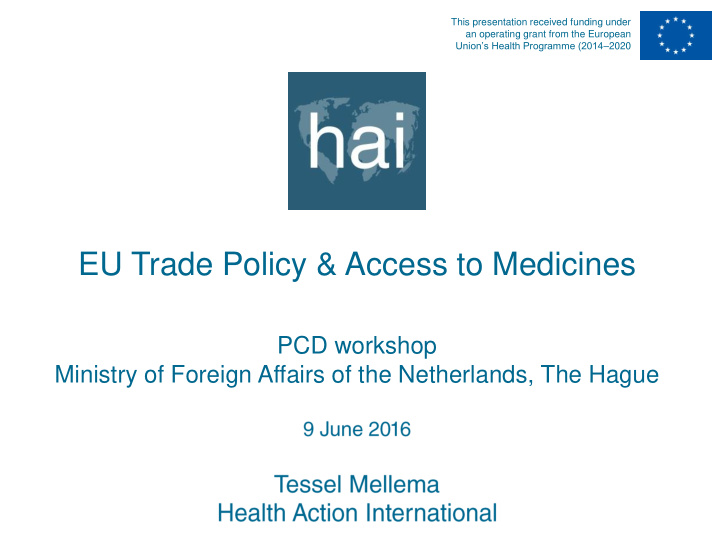



This presentation received funding under an operating grant from the European Union’s Health Programme (2014– 2020 EU Trade Policy & Access to Medicines PCD workshop Ministry of Foreign Affairs of the Netherlands, The Hague
Health Action International (HAI) • Established in 1981 • Goal: improve access to affordable and quality-assured medicines and promote rational use • Network of health care professionals, academics, public health NGOs and individuals • European projects: monitor and research impact EU trade, intellectual property, R&D and medicines’ policies
Background • 1/3 population lacks access to essential medicines • Price major barrier for access in LMICs • New patented medicines priced out of reach even for high-income countries
Monopoly prices patented medicines: key barrier access
Generic competition brings down prices
EU trade agenda since TRIPS & DOHA
Example TRIPS-plus (I)
Example TRIPS-plus (II) Patent term extensions • Additional protection periods to compensate for ‘delays’ in marketing authorisation • Delay generic competition
Impact TRIPS plus
Bilateral pressure (I) European Commission pressure on South Africa
Bilateral pressure (II): Colombia • Imatinib (Glivec) effective leukemia drug (WHO EML) • Marketed at USD16,000 p/y GNI per capita USD 8,000 • Estimated price reduction generics about 68-77%
EU trade policy harms access to medicines • Direct impact on access to affordable medicines by imposing TRIPS plus and bilateral pressure on countries using TRIPS flexibilities • Growing criticism EU level of TRIPS plus protection for pharmaceuticals
…price new medicines has exploded • Influential oncologists: prices new patented cancer medicines ‘ astronomical, unsustainable and even immoral ’ • Prices set according to the maximum of what the market is ready to pay, while the real costs of R&D remain unknown • Companies spend more on marketing than on R&D
… patents drive innovation towards markets that can pay • Neglected areas of R&D despite of public health importance Antibiotic resistance Combination of existing drugs neglected tropical diseases • Despite increased IP protection: new medicines few benefits
Impact current patent-driven model & need for alternatives high on political agenda • EU Council Conclusions pharmaceuticals , June 2016: Need to critically examine the impact of the current over- protection and misuse of IP and related rights for pharmaceuticals, to assure availability and affordability of medicines • EP: INI report on Access to Medicines (Oct 2016) • Council of Europe resolution 2015: to ensure accessibility of affordable and innovative medicines in the long term, the Assembly calls on the WHO to put forward alternatives to the current patent-based pharmaceutical innovation model • UN High Level Panel on Access to Medicines (report July 2016) • WHO : process to improve financing and coordinating and explore new incentives for R&D to meet global health needs
What is needed: Policy Coherence between EU trade, R&D and development policies • EU trade policies need to be coherent with development goals on access to medicines • EU trade policies need to reflect growing consensus on negative impact ever increasing levels of monopoly protection for pharmaceuticals on development of affordable and needed medicines • Risk exporting a ‘broken’ IP system
EC Review EU Trade & Investment Strategy EU FTA (India, MERCOSUR, Thailand) • Develop a coherent access to medicines policy that ensures that its trade policy is consistent with its development, research and global health goals • Not use FTAs with LMICs to introduce TRIPS-plus IP rules • Actively support governments that use TRIPS flexibilities to protect public health • Immediately stop targeting countries that have implemented progressive TRIPS-compliant IP policies that promote access to medicines
Thank you tessel@haiweb.org www.haiweb.org
EU IP and R&D policies • Need to critically examine the impact of the current over-protection and misuse of IP and related rights for pharmaceuticals, to assure availability and affordability of medicines Support EU Council Conclusions (17 June) • Explore alternative innovation models that delink the cost of R&D from the price of the medicine to steer R&D towards priority health needs Use Horizon 2020 and Member State biomedical R&D funding to explore alternative innovation models Ensure that the EU takes an ambitious and progressive position in the WHO process to explore alternative incentives
Recommend
More recommend